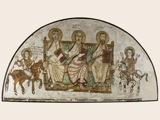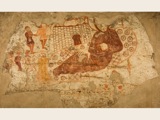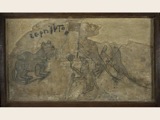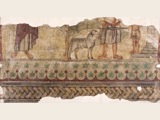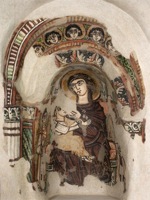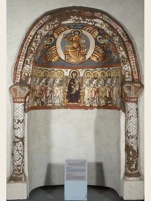Inv. No. 12090
Tempera
H: 165 cm, W: 335 cm
Bawit, Monastery of St. Apollo, 6th / 7th century
The monastery of Bawit has become famous for its colourful frescoes. This example shows St. Apollo, the founder of the monastery, in the centre of the wall painting. His name is written above his head: Agios Apollo, “Saint Apollo”. Two unknown saints are placed next to him on a bench. At the corners of the fresco two warrior saints are seated on richly harnessed horses. They raise their hands in prayer.
Fresco with the Nativity
Inv. No. 11487
Tempera
Nubia, Church of Abdalla Nirqi, Late 10th century
Christianity began to spread in Nubia around the 5th century. In this example of Coptic art in Nubia, the Virgin Mary reclines on a bed evoking the influence of Byzantine art. Behind her in a manger lies the newly born Christ. Joseph is seated on a cushion in front of them; behind him the three Magi approach the Holy Family on horseback. Two shepherds in the background witness the birth of Jesus. When the High Dam in Aswan was built this mural fragment and other pieces from the church of Abdalla Nirqi were transferred to the Coptic Museum to rescue them from the rising waters of Lake Nasser.
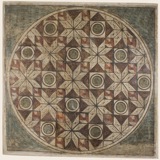
Inv. No. 8438
Tempera on mud plaster
177 x 177 cm
Bawit, Monastery of St. Apollo, Hall 6, 6th/7th century
Panels with geometrical patterns once adorned the lower parts of the walls of an architectural structure that was probably used as a refectory (dining room). Archaeologists discovered twenty panels, the design of each of which is unparalleled. The geometrical decoration was executed using a compass and imitates a precious mosaic.
A cat and three mice
Inv. No. 8441
Tempera on limestone
H: 45 cm, W: 80 cm
Bawit, Monastery of St. Apollo, 7th / 8th century
The depiction of animals acting like human beings reaches back as far as 1500 B.C. Three mice are walking on their hindlegs towards a cat. The mouse in the centre carries a banner clearly indicating that she and her companions are suing for peace. This scene was retained from the wall of a monk’s cell at the monastery of Bawit. It is either to be understood as a satire indicating a political issue or a funny story for the mere amusement of its owner.
Fragment of a fresco showing the sacrifice of Abraham
Inv. No. 8411
Tempera
H: 100 cm, W: 230 cm
Saqqara, Monastery of St. Jeremiah, 6th / 7th century
Abraham sacrificing Isaac has been a popular story in Coptic art and has been applied to different materials such as wood, textile or stone. Although the upper part of the fresco is missing, the individual figures can be clearly identified. Abraham holds a sword in his right hand. Next to him his son stands on the first step of a flight of stairs leading to an altar. On the left side of Abraham a ram, the substitute sacrifice, is shown under a tree. An unknown figure occupies the left edge of the fresco.
Wallpainting showing Adam and Eve
Inv. No. 3962
Fresco
Tebtunis (Um el-Beregat, Fayoum), 11th century
This unique fresco represents Adam and Eve before and after their fall from grace. To the right they are depicted without genitals, innocent and unashamed. Next to Adam a horse tied to a tree symbolizes the control of evil. To the left Adam and Eve hide their shame with fig leaves after eating from the forbidden tree. Next to Eve’s head a snake symbolizes the fatal seduction. A Coptic script along the upper edge of the fresco describes their banishment from the Garden of Eden.
Decorated prayer niche
Inv. No. 7987
Tempera
Saqqara, Monastery of St. Jeremiah, cell 1725, 6th / 7th century
Excavations at the Monastery of St. Jeremiah in Saqqara have yielded several niches that were pierced into the eastern walls of monks’ cells and served the monks for prayer and contemplation. These niches bear christological scenes showing the enthroned Jesus or Jesus Pantocrator. Two niches are decorated with the Virgin Mary nursing the infant Jesus. Here she is flanked by angels and saints. The infant holds the left arm of the Virgin with both hands. “Mary lactans” alludes to the Pharaonic mother goddess Isis nursing her son Horus.
Decorated niche
Inv. No. 7118
Tempera
Bawit, Monastery of St. Apollo, 6th / 7th century
The external rim of this famous niche features a slightly protruding frame and two adjoining colonettes with simplified capitals. In the upper section Christ is enthroned in a mandorla (enclosed in an oval) carried on wheels with flames thrashing at its base. At the sides of the mandorla are the heads of the four creatures of the apocalypse that are also associated with the four evangelists: the eagle (St. John), ox (St. Luke), lion (St. Marc), and man (St. Matthew). The archangel Michael stands on the left while, Gabriel on the right. In the lower section the enthroned Holy Virgin, holding the infant Jesus, is flanked by the twelve apostles and two local saints.
